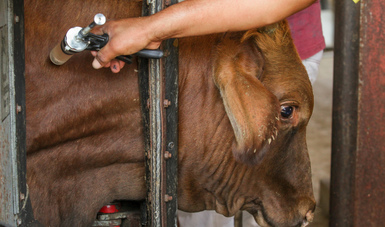



Mexico trains more than 2,000 veterinarians to identify serious animal diseases
Mexico is training veterinary students and others in related careers to identify serious livestock diseases threatening Mexico's livestock.
Agriculture has virtually trained 2,471 students, technicians, livestock producers and state officials, so that they can identify injuries and clinical signs in animals, caused by diseases not present in Mexico.AuthorSecretariat of Agriculture and Rural DevelopmentPublication dateAugust 01, 2021CategoryRelease
The Ministry of Agriculture and Rural Development has virtually trained - from September to-date - 2,471 students, technicians, livestock producers and state officials, so that they are able to identify injuries and clinical signs in animals, caused by diseases not present in Mexico.
The online course "Main exotic diseases of animals (AUTOSIM)" is taught by specialists from the National Service for Agri-food Health, Safety and Quality (Senasica).
It was created as an alternative to the face-to-face course that the agency has operated for 35 years and that has made it possible to strengthen the systems for the timely detection, control and eradication of some of the most devastating animal diseases, Agriculture reported.
He explained that AUTOSIM's main target audience is veterinary medicine students and related careers, since in the coming years they will be in charge of preventing, and where appropriate, controlling and eradicating threats to national livestock.
Of the 25 institutions that requested the course, 16 belong to the academic branch, three to the productive sector, three to livestock aid agencies, a state Rural Development secretariat and two areas of Senasica.
Among the universities are 209 students from the Veterinary Sciences Research Institute of the Autonomous University of Baja California, 204 from the Michoacan University of San Nicolás de Hidalgo, 194 from the Benemérita Autonomous University of Puebla, 175 from the Autonomous University of Guerrero, 158 from the Autonomous University of Sinaloa, 139 from the University of Guanajuato, and 137 from the Autonomous University of Baja California Sur.
For the productive sector, 238 technicians from the Mexican Pig Farmers Organization (Opormex) and 153 from Federal Inspection Type Establishments (TIF) have been trained.
Also, 103 technicians from the Chiapas State Committee for the Promotion and Protection of Livestock, 44 from Campeche and 13 from Tlaxcala were registered.
Finally, seven officials from the Secretariat for Agricultural Development of the State of Querétaro, 128 technicians from the United States-Mexico Commission for the Prevention of Foot-and-Mouth Disease and other Exotic Animal Diseases (CPA) and seven from the Monitoring Department took the course. and Project Control of Senasica.
The training consists of six modules: vesicular diseases, such as foot-and-mouth disease; arboviral, such as equine encephalitis; plague type, such as swine fever; dermal, such as bovine besnoitiosis, and prion, such as bovine spongiform encephalopathy, among others.
The modules are self-taught in approximately 32 hours, so that the participants can distribute the study time according to their needs, since they can enter the virtual classroom 24 hours a day.
Upon completing the course with a minimum average of 7.0, participants obtain a certificate endorsed by Senasica.
To access the AUTOSIM course, those interested should ask their institution to send a formal request to the email: [email protected] or they can obtain information by calling 55 5905 1000 extension 51243.
Once the General Directorate of Animal Health receives the applications, it opens new virtual classrooms, so it has the ability to provide training to the institutions that require it, the agency said.









